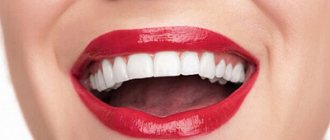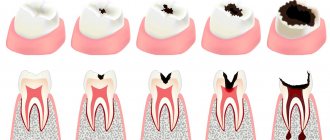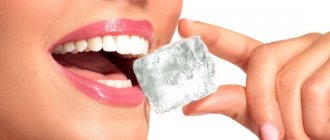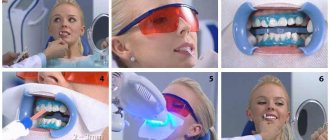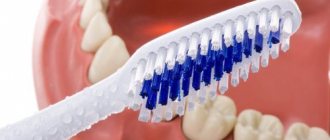The question of how to open a brace yourself worries many patients who are undergoing orthodontic treatment. Before opening the brace lock, you need to understand that only a professional orthodontist can do this correctly and as safely as possible. It is advisable to perform these manipulations in cases where there is a need to replace the arc or correct a problem that has arisen. Doctors do not recommend opening the lock at home. Quite often, when patients try to open the lock on their own at home using improvised objects, this leads to breakdown of the structure. In today's article we will talk about how to open a brace as carefully and safely as possible without the help of a doctor.
The bracket has come off - what to do, how to unfasten and remove the structure?
Correcting the bite, eliminating gaps between teeth, and straightening the dentition were previously possible only in childhood.
With the advent of braces, adults can also make their smile more beautiful. Modern designs make it possible to effectively adjust the position of each individual unit and therefore have become widespread. However, in some cases, wearing braces can cause discomfort. This happens when the attachments move away from the teeth, the bracket comes off, and the structure weakens. Since such products are not cheap, it is important to troubleshoot problems in a timely manner. Often the patient can do this on his own.
The principle of operation and fixation of braces
Braces are structures that apply measured pressure on the teeth. Teeth do not remain motionless throughout life, and maintaining their correct position depends on many factors (proper nutrition, eating hard foods, gum health). Inflammatory processes weaken the tissues of the oral cavity, and teeth can move.
Various loads over time lead to the fact that individual units rotate, tilt, and shift relative to their original position. At the same time, gaps appear between the teeth, in which food debris accumulate and pathogenic microorganisms multiply, which leads to the development of caries and inflammatory processes in the gums.
To correct the situation, the coronal part must be affected in a certain direction. Under the influence of a constant force, the unit begins to move. The bone in front of the tooth gradually softens, allowing the root to take a new position. The tooth “moves” to a new location.
This process can take up to several years, which is why people often resort to braces. These fixed structures are designed to correct the position of incorrectly positioned teeth.
Small plates of braces are glued to each tooth. Each part has a groove and a special arc passes through it. It is given the desired shape of the dentition. Because the teeth are in the wrong position, the arch becomes bent. Trying to return to its original shape, the arc puts pressure on the incorrectly growing units, forcing them to move.
The pressure force is approximately equal to that with which the blood presses on the capillaries of the periodontal ligament. Too much pressure leads to compression of the capillaries, stopping cellular activity. Insufficient pressure will not cause the units to move.
Most brace systems are of the vestibular type. In such designs, braces are attached to the front wall of the crown; they are visible when talking and laughing.
There are also lingual braces, the plates of which are attached to the tooth from the inside. This design is almost invisible, but creates discomfort in the oral cavity, because...
the tongue is constantly in contact with the device. Temporary disturbances in diction are possible.
READ ALSO: Is it possible to do an MRI procedure with braces on teeth?
Reasons for braces coming off teeth
Braces take up significant space in the mouth. It takes time to get used to them - a month is considered the minimum period.
To ensure that the braces adhere firmly to the surface of the crowns, they are secured with special glue. After installing the structure, the doctor warns the patient about the limitations associated with treatment with braces.
The safety of braces depends on following these recommendations. Why braces can come off:
- during the first stage of connection, devices may be subject to pressure from incorrectly positioned units;
- a bracket fell off - it was all due to careless manipulations with a toothbrush;
- if the bracket came off, the food consumed was too hard or sticky;
- the device may fall off when trying to remove food stuck between the teeth or under the arch;
- The safety of the structure is affected by changes in the dentition, gradual correction of the bite, which can also cause a violation of integrity, and the bracket will fall off.
Consequences of violation of system fixation
What to do if the plate comes off? If the brace system breaks down, efforts aimed at straightening the row or correcting the bite will be in vain. The design on the teeth will change the pressure and direction of action, which will cause harm to the dentition.
Do not be alarmed if you find a part of the structure that has come off in your mouth; you should immediately consult a doctor. It will help restore the integrity of the system and tell you what to do next so that the situation does not repeat itself.
If you can’t see an orthodontist, you can try to repair the broken bracket yourself. There are 2 options for this repair: glue the plate using special wax or remove the lock.
How to fix braces at home?
When it is not possible to immediately see a dentist, you can temporarily repair the damage at home. If a ligature system is installed in the mouth, the ligature must be released using small tweezers or a toothpick. The released ligature will allow the bracket to be removed.
To remove the ligature-free system, carefully unfasten the locking lock. Removed braces must be retained.
If you consult a doctor in a timely manner, the structure may be able to be replaced. However, in most cases the system will have to be manufactured anew, because
in a re-attached device, the load on each unit will change, and the fixation will not be secure enough.
Unstuck braces can be glued back using special wax, which specialists use to attach plates to crowns. Orthodontic wax can be obtained from your doctor during the installation of the system.
Before gluing the fallen off plate, the crown should be wiped dry with a cotton swab or ear swab.
However, it is important to remember that if the bracket has separated from the last unit, you should not do anything on your own without the help of an orthodontist.
If you cannot open the lock or remove the ligature yourself, you should not use strong force. It is better to leave everything as it is and consult a doctor as soon as possible. The less time passes from the moment of breakdown, the more likely it is that the defect can be eliminated without making a new structure.
Source: //AzbukaZubov.com/ortodont/breketi/otkleilsya-breket-chto-delat.html
How to avoid complications
Many patients note that removing braces does not hurt, except that the process of unsticking the locks causes slight discomfort. This is especially felt with increased sensitivity of the enamel. However, complications after wearing structures still occur. They are often associated with non-compliance with hygiene rules during orthodontic treatment. Immediately after installing braces, a person should change their diet and spend more time brushing their teeth and braces. To do this, use special brushes, brushes, dental floss and mouthwash.
Doctors also recommend cleaning your mouth 2-3 times a week with an irrigator. It allows you to eliminate food debris and bacteria even from hard-to-reach places: interdental spaces, under the arch, around locks, etc. When buying an irrigator, choose a model with attachments that are compatible with orthodontic structures, for example, Donfeel Donfeel OR-820D Compact, Revyline RL 100, Panasonic EW-1411 or Revyline RL 200XL. Please consult your dentist before purchasing such devices.
Dental repair: how to insert an arch into the last bracket?
The arch in braces plays the main role: due to its efforts, the alignment of the dentition occurs.
When fixed in the grooves of the braces, it takes the original shape of the row. The wire tends to straighten out to return to its shape. Along with it, the position of the teeth also changes.
one for each row of teeth . Braces will not work without it, so you need to make sure it always in place.
ontakte
Odnoklassniki
During the treatment process , the arch on the dentition replaced rigid fixation is required. On average, there are only 3 planned replacements: at the beginning, middle and end of treatment.
Important! An individual treatment plan, the degree and type of defect determine how many times replacement is necessary.
The structure can also suddenly break down due to improper care, use, installation or poor quality material. If the arc is broken, it is no longer suitable, in which case an unscheduled replacement is necessary.
procedure does not take much time and is painless . The dentist opens the clasps on the braces and removes the old wire from the grooves. Instead, a new one is installed in the grooves and then secured with locks.
Planned replacement usually involves installing new arches on two jaws . In case of an unscheduled one , only the one that is out of order is replaced.
Arches for braces, their cost and types according to the material of manufacture
Based on the material used, arcs are divided into the following types :
- Stainless steel . This is the standard option and is the most popular. It combines quality and low price. Steel is elastic and has a high degree of rigidity. At the beginning of orthodontic treatment with braces, a woven steel arch is used, and then a solid one.
- Titanium with molybdenum . In the middle of treatment, this type is installed. They are both elastic and tough. This alloy is less likely to cause allergies and minimizes possible discomfort while wearing braces.
- Titanium with nickel . These are much more elastic than the previous ones and less rigid. They are used at the initial stage.
- Alloys of copper, nickel and titanium.
Important! The decision to use one or another type of metal or alloy is based on the degree and type of pathologies and individual characteristics of the patient.
By type of section: round, rectangular, square
Arcs are also distinguished according to the type of section :
- Round - thin and elastic. They are used at the beginning of correction, as they have the smallest force on the teeth. Such specimens are thermodependent (they change qualities and properties when heated and cooled). While wearing, doctors advise not to eat foods with different temperatures at the same time, for example, cold yogurt and hot coffee.
- Rectangular - characterized by medium rigidity and traction force, so a rectangular arch is used in the middle of treatment.
- Square ones are the toughest. They completely fill the grooves of the braces. Used only at the end of correction.
Photo 1. A rectangular arch on the upper jaw, unlike a round arch, its interaction area is larger, and accordingly the force applied to the tooth increases.
How much do wires for braces cost? The average price of one piece is 600 rubles .
Replacing the arc if it pops out or breaks
The arch quite often jumps out of the braces, and you need to treat this calmly, without panic, there is nothing critical about it.
How to insert an archwire into the last bracket
In patients, the archwire can often fly out of the last bracket, for example, while eating. In this case, you can insert it back yourself .
The lock on the last bracket never opens , so the part that came out will need to be inserted.
Bend strongly and carefully insert it into the hole in the bracket lock (similar to threading a needle), using tweezers.
If the arch is too rigid , you will need the help of another person, as you will need to apply a lot of force.
Important! If you are unable to put the arch in place yourself, you should contact an orthodontist at your nearest dental clinic . The specialist will very quickly restore the functionality of the braces system.
If the piece that came out could not be inserted and it began to rub orthodontic wax will help in this case .
Elimination of discomfort after activation
If the discomfort is severe, then taking painkillers (for example, Ibuprofen) is allowed. You can also use other methods to reduce pain. Here are the experts' recommendations:
- Changing your usual diet. The menu should consist of soft foods (soups, purees, puddings and similar dishes).
- Using cold compresses.
- Applying a gel with an anesthetic effect to the gums.
- Rinse your mouth with salt water.
- Use a soft toothbrush and toothpaste that does not contain abrasive particles.
Making braces at home - interesting tips
June 23, 2016 Last revised: February 1, 2022 Braces
It is a pity that not everyone in our world is naturally blessed with beautiful and straight teeth. Many people resort to considerable effort and great expense in order to have a more or less aesthetic smile.
After all, uneven teeth are not only unsightly in appearance, but also cause serious changes in the bite, which in turn leads to various diseases. Of course, only an orthodontist can perfectly straighten the teeth, for example, by installing a braces system.
People often ask whether it is possible and, if so, how to make braces at home?
More recently, people were embarrassed to wear braces. They considered this system ugly and unaesthetic. Therefore, even when talking, they tried to cover their mouth with their hand. Today you can notice completely different behavior.
Braces are considered not only a necessary device for straightening teeth, but are also trendy devices that add a certain zest to a person.
Now people are proud of the braces on their teeth and show them off to everyone.
Today you can often find a variety of information about home teeth straightening. Let's try to figure out how this is done.
To be objective, let’s say right away that it is possible to create braces at home, but you won’t be able to correct your teeth with home braces, but you can add some shock value to your image. Homemade braces are good to wear to a disco or to a photo shoot.
Instructions for making braces
How to make braces? Not very difficult. You can make devices from available items.
Here is a list of materials that will be needed during the process:
- Large size paper clips.
- Wire.
- Paper plate or other convenient surface.
- Sandpaper.
- Super glue.
- Pliers.
- Orthodontic wax.
- Beads (preferably different colors).
- Earrings in the shape of a butterfly.
So, let's describe the technology of how to make braces at home.
Braces at home from a paper clip
- Bend the object into a straight line.
- Make the paperclip into the shape of a tooth row, that is, bend it in a U-shape.
- Go to the mirror and stretch your mouth into a smile. Assess how many teeth are visually visible. By counting them, you will find out how many beads you will need in the future.
- Take the beads and attach them to the paperclip.
Remember to maintain the correct distance between objects, equal to the distance between the teeth. The beads should be located directly in the center of the tooth. Now raise the paperclip to your teeth and smile widely. Evaluate what has been done. - Place the paper clip on the paper surface and glue the beads to the wire with non-toxic glue.
The beads should stick very well to the paper clip. There should be enough glue. During gluing, the beads and paper clip should not stick to the paper surface. If excess glue suddenly forms, it must be carefully removed from the wire. Average holding time of a glued structure: 4 weeks. - Make the beaded paperclip into an L shape using pliers.
Make folds on both sides. At the same time, try to achieve a level base. Be patient and do the folds slowly. - Take orthodontic wax (you can find it in pharmacies.) Make two balls from it. Thread the ends of your homemade braces through these balls. For fastening, in addition to wax, you can use chewing gum.
- The structure is ready.
Secure it to your teeth for a comfortable feeling.
Sequence of making wire braces
- Take silver craft wire. Give it a U shape.
- Make hooks from the ends of the wire for fastening using pliers. In this case, there is no need to bend them until the very end.
- Choose a suitable elastic band. Find a rubber band that is not too thick and is long enough that it stretches across all the front teeth.
- Attach the elastic band to the wire. Perform movements carefully so as not to damage the structure. Hang the elastic on one hook, pull it tight and secure it on the next side. Squeeze the hooks using pliers. The elastic band should hold very tightly.
- Take small earrings that look like a butterfly. Number of earrings needed: 6. Attach this number. In this case, the back of the earrings should be on the wire.
- Make a fitting to align the butterflies. After assessing the result, make the necessary movements so that the earrings are in the center of the teeth.
- Prepare brackets for the bottom row. The execution sequence differs little from creating braces for the top row. The only thing you won't need to do is attach butterfly earrings. The quantity made will be enough for the aesthetic appearance of the structure.
Making Tips
You need to be careful when creating braces at home. During the manufacturing process, it is better to follow the tips listed below:
- The parts used must be clean. An infection can easily be introduced into the oral cavity and subsequently treated for complications.
- Wire, beads, earrings and paper clips should not contain sharp ends. Otherwise, you may seriously injure your mouth area.
- The fastening of parts of braces must be done conscientiously. Small parts that fall off can get into the throat and cause suffocation.
- If homemade braces are made by a child or teenager, the procedure must be performed under the supervision of elders.
- Be sure to remove your braces from your mouth when eating.
- Don't waste your time. Treat the process meticulously and painstakingly.
- When doing this, try to make your homemade structure look like the real thing.
- The shape of the paperclip or wire should not contain folds or irregularities. The surface of the product should look like a clear letter “U”.
- Before bending the edges, you need to clean the tool and apply sandpaper.
- Remove braces when eating.
- It is better to eat before installing homemade braces.
- You should be careful when bending a paper clip in your mouth because you can very easily injure yourself.
- When trying on the design, try not to choke on the parts of the braces.
If you don’t want to make braces yourself, you can buy them in a store and put them on your teeth. But be aware that purchased braces greatly cover your teeth.
Tips for straightening teeth
Self-made braces at home will, of course, add pathos to the image. But you still need to straighten your teeth with the help of an orthodontist. In addition, it is important to know that dental defects are not always a genetic problem. It often occurs due to a number of factors:
- Excessive consumption of only soft foods. Solid food trains the chewing muscles well. The teeth are practically not subject to movement.
- Bad habits of a child: biting the lower lip, attachment to the pacifier, constant sucking of foreign objects.
- Frequent breathing through the mouth. A healthy person should breathe only through the nose.
- Lack of microelements, especially calcium. Its deficiency will certainly lead to thinning of tooth enamel and loss of stability.
Important! The bracket came off, what should I do?
The main consequences of crooked teeth
- The load on teeth changes significantly due to their unevenness. As a result, excessive sensitivity appears and, over time, healthy teeth are destroyed.
- A deformed bite provokes intolerable pain in the mouth and jaw. This pain can easily radiate to the ear.
- Installing a denture with uneven teeth is much more difficult.
- It is impossible to properly digest food with distorted teeth. Poorly chopped food subsequently leads to gastritis, bloating and a feeling of heaviness. Obesity even happens.
- Due to defects in teeth, caries and other serious dental diseases occur.
- Uneven teeth are more difficult to clean. Therefore, because of this, inflammatory processes most often occur.
- A smile with ugly teeth adds a lot of negative emotions to its wearer. As a result, a person’s self-esteem decreases and confidence in their own abilities is lost.
To maintain straight teeth, you need to take preventive measures
- Don't breathe through your mouth. The breathing process should be carried out through the nose.
- You need to pay attention to uneven teeth early, in childhood. This preventive measure will help an adult have a beautiful smile.
- Do not suck on foreign objects.
- Do not let a small child suck on a pacifier or delay weaning.
- Conscientiously keep your teeth and gums clean. Use mouthwash after meals.
- Visit the dentist.
Sources used:
- //star-smile.ru/
- Borkowski RN The biologically based case for truly light-force mechanics, Clinical Impressions, Vol 13 (1), 2004, p 19-22.
- "Orthodontics. Textbook for dentists" (Kutsevlyak V.I.)
- Colgate 32%, 2742527425 32%27425 – 32% of all
- Splat 24%, 2066820668 24%20668 – 24% of all
- ROCS 16%, 14254 votes14254 votes 16%14254 votes – 16% of all
- Sensodyne 11%, 96499649 11%9649 – 11% of all
- New pearls 11%, 92769276 11%9276 – 11% of all
- President 6%, 54755475 6%5475 – 6% of all
Source: //CreateSmile.ru/kak-sdelat-brekety/
Indications and contraindications
Indications for installation of the Damon bracket system
— Correction of bite, uneven teeth. — Elimination of interdental gaps. — Crowding of teeth in a row. - Excessive development of one jaw in relation to the other. — Dystopia. — Introduction of unerupted teeth into the dentition. — Preparatory stage of prosthetics. — Body movement of crowns
Contraindications for installing Damon braces
— A large number of fillings on the teeth. - Severe somatic diseases.
Fake braces - a fashion trend or a full-fledged method of treatment?
591
If not so long ago most orthodontic patients refused to straighten their teeth or correct their bite with braces due to their unattractive appearance, today even public people resort to this method of treatment.
Treatment is quite expensive, and some segments of the population cannot afford such devices.
The fashion for metal fake braces on teeth came from Asia, and the products became a trendy decoration.
Fake designs are bought by teenagers and young people imitating their favorite actors and singers.
General overview
Fake braces are structures that look like an orthodontic system. They are made independently or bought ready-made.
Plastic and various metals are used for manufacturing. False structures are used to create a fashionable image, at themed events, and for photo shoots.
History of origin
For the first time, fake braces began to be worn in Southeast Asia. The fashion for them was introduced by such stars as Andiga Kangen, Earn The Star, Gwen Stefani. They are also associated with the aggressive “dek wehn when” motorbike subculture.
Counterfeit products are designed to create the image of a rich person. For example, the cost of real structures in Bangkok is more than $1,000. This amount is equal to half the annual income for most residents of the country.
A huge demand for products has created a black market. On it, fake systems cost about $100.
The fakes turned out to be life-threatening. After the death of teenagers in Thailand, their sale is prohibited by law.
Violation is punishable by 6 months in prison and a $1,600 fine.
But some enterprising young people are not afraid of statistics, and they resort to creating beautiful dental jewelry on their own.
Method 1
To make it you will need a paper clip or wire, orthodontic wax, foil, sandpaper. The structure is prepared in the following sequence:
- Cut off the required section of the wire or unbend the paper clip.
- They are formed into a “horseshoe”.
- Smooth the ends with sandpaper and wrap with insulating tape.
- Balls are formed from small pieces of foil or beads are taken.
- Attach them to the main element.
- Orthodontic wax is applied to the created structure and pressed against the teeth.
Note! An incorrectly sized wire will damage soft tissue.
Method 2
The second method uses a paper clip and cheese wax. Follow these steps:
- Remove the wax from the packaging of Babybel cheese.
- Give it a semicircular shape and place it on the dentition.
- After hardening, it is removed and one side is treated with non-toxic glue.
- Let the glue dry.
- Decorate the structure at your own discretion.
- The paper clip is cut into four parts and placed in wax.
Important! All elements from which the devices are supposed to be made must be sterile and non-sharp!
Aliexpress and Jum sell fake braces of various designs - with flowers, Mickey Mouse, and Hello Kitty. They are made of clear plastic and are compatible with autoclave or cold sterilization.
Their minimum cost is $1. You cannot eat, drink or run in such devices. Be careful not to swallow small parts.
The dangers of self-medication
False systems are made from soft materials that do not correct bite defects and do not straighten the dentition. They are used for decorative purposes.
Asian beauty salons offer installation of such systems. Devices are placed without examination by an orthodontist, which increases the risk of an unfavorable outcome.
When wearing fake structures, there are the following complications:
- Getting small parts into the respiratory tract or esophagus.
- Formation of ulcers on the oral mucosa.
- Lead intoxication.
Important! Inflammatory diseases (gingivitis, periodontitis), the development of caries, and the formation of cracks in the enamel are possible.
Long-term wearing of fake braces leads to jaw failure, deformation of the dentition, and an aesthetic defect.
There have been two reported deaths associated with wearing false braces. Such data was published by the international magazine Vice.
One is caused by heart failure due to a thyroid infection. Given the high health risks, it is better to avoid installing fake structures.
Competent approach
Before installing an orthodontic system, a consultation with a dentist is required. It includes examination and instrumental examination.
During examination, the structure of the face, posture, and features of defects in the jaw rows are determined.
Instrumental examination
Orthopantomogram is a panoramic photograph of the dentition. It is used to determine the location of the teeth and their rudiments, and to identify supernumerary and impacted teeth.
The examination provides information about the degree of formation of the tooth root, the availability of space for the growth of third molars, and the level of bone tissue.
Teleroentgenogram is a photograph of the head in a lateral projection. The study helps to calculate the angle of the skull structure, which changes during the treatment process. It is used during the period of growth or in cases of severe skeletal deformation.
Additional Information! Taking into account the examination and radiography data, the necessary braces parameters are selected.
Second visit to the doctor and measures before installation
At the repeated consultation, impressions of the jaw rows are taken and control models of braces are prepared.
They also try them on, tell you about proper care of the structures, and teach you how to properly brush your teeth. The doctor recommends special brushes, pastes, foams and rinses.
The dental clinic performs a professional cleaning before installing the system. If necessary, inflammatory processes of soft tissues are treated, fillings are placed, and foci of infection are sanitized.
If these measures are not followed, bone resorption, pathological mobility or tooth loss may occur.
Additional events
In patients with weak enamel, a course of remineralization is carried out. It lasts from 1 to 6 months. Particular attention is paid to children under 10 years old - it is recommended to cover the 6th and 7th teeth with sealant.
If nasal breathing is impaired or other pathology of the nasopharynx, a consultation with an otolaryngologist is prescribed.
Only with a preliminary examination by a dentist and following the recommendations for caring for the structure can you correct bite defects and maintain your health.
Option 2
Do not try to remove a loose bracket if it is tightly held in a metal arch. In this case, the best option is to do nothing until you see a doctor. If you are afraid of losing the plate while eating or brushing your teeth, you can temporarily secure it with special orthodontic wax. It’s definitely not worth trying to forcibly tear the bracket away from the structure, because you can damage the entire device. In this case, it will need to be completely replaced, which will cost a lot of money and time.
Using wax
Before the advent of high-quality silicone protection, dentists recommended that patients use wax pads for similar purposes. Practice has shown that wax, in comparison with silicone, has a number of disadvantages, including:
- difficulty in removing the structure - wax particles can remain on the elements of the dentition;
- Average quality of fastening - silicone fits more tightly and does not change its position during operation.
Medical studies have proven that silicone is more reliable and of higher quality. However, this conclusion does not exclude the possibility of using wax protection in cases where an alternative is not available.
What can you eat with braces?
There are no big prohibitions on certain foods during orthodontic treatment, but it is better to adhere to the following rules:
- In the first days after installation and activation, while your teeth ache, it is better to eat soft and liquid food - porridge, puree soups, smoothies, yoghurts and curds. This will make it easier to get used to your new state.
- There is no need to eat sticky foods that can get stuck in the braces and damage them. And even if they don’t damage them, it’s difficult to clean them out later. Therefore, toffees, caramels, chewing gum, as well as cookies, baked goods, and other foods that become sticky when chewed are prohibited.
- Do not eat hard foods - crackers, nuts, pieces of meat, etc. — they can easily damage your braces. For the same reason, cut raw vegetables and fruits into small pieces.
- Don't forget that products such as tea, coffee, colored drinks, beets, blueberries, etc. may change the color of some types of braces and ligatures on them. And sitting in a cafe with a brace system full of, for example, red beets is not very aesthetically pleasing. So think about it.
- If your brace system has thermo-active orthodontic wires, then you cannot eat ice cream or drink ice water. The fact is that at ordinary temperatures a thermoactive arc can be given any shape. Then, under the influence of a person’s body temperature, it “remembers” the shape that was put into it during production and begins to work. And here you are with your ice cream...
What are the risks of arc failure?
If the arc breaks, great care must be taken. This is the main part of the overall design. The fracture site, as with a normal bracket peeling off, should be fixed with wax and a doctor should be visited as soon as possible.
What should you do if you swallow a piece of an archwire that has broken off from your braces?
An arc is an oblong piece of wire. It is better if it has curved edges that will not cling to soft tissue as it moves along the gastrointestinal tract. Usually, under such conditions, the wire leaves the body naturally without pain.
Problems arise if the ends are not rounded. A relatively successful option is to insert the wire into the soft tissue of the esophagus. In such a situation, the foreign element can be removed without undergoing an expensive operation.
If you swallow an archwire, you need to visit a surgeon as soon as possible, and before that, make a minimum of active movements, trying not to push it down the esophagus.
Eating is strictly prohibited to avoid aggravating the situation. You can drink, but be careful.
An x-ray will be needed to accurately determine the location of the arc. Based on the X-ray results, the surgeon will be able to remove it as safely as possible.
It is also possible that ligatures or individual braces may be swallowed. In such a situation there is no reason to worry. These elements will either dissolve in the gastric juice or leave the body along with waste from the digestive system.


